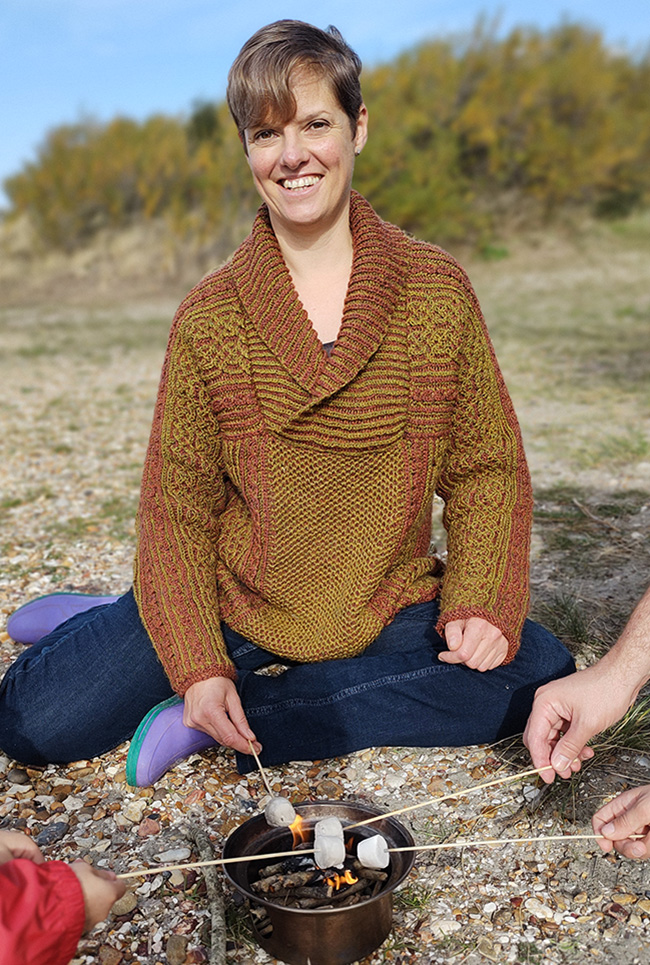Substitution Solutions, a column where a spinner uses her knowledge of fiber, yarn construction and knitting to substitute yarns by Jillian Moreno
INTRODUCTION
Substitution Solutions
How to substitute yarn in a pattern
It’s so important for a knitter to feel comfortable substituting a yarn. More and more designers are offering substitution ideas in their patterns, or at least a description of the type of yarn to look for when choosing a substitute, and you'll find helpful descriptors of Yarn Characteristics in every Knitty pattern starting with Winter 2021.
In this column, I will walk you through substituting yarn for a couple of patterns in the current issue. My choices are based on how I – as a spinner – look at a yarn and a pattern, making choices based on what I know about fiber, yarn construction, and knitting. Even if the recommended substitution yarns are discontinued one day, my hope is that the information below will make the process of choosing a yarn less daunting, and help you knit projects that give you joy in the knitting and wearing.
I’m little excited about using woolen yarns for this issue’s substitutions. Spinning fiber in a woolen style gives it very particular qualities. Woolen-spun yarns are warm, the have a bit of a fuzzy halo, they are light, and they aren’t as consistent and have softer stitch definition than worsted spun yarns.
There is absolutely nothing wrong with the great yarns that our designers have chosen for their projects, I’m just giving my opinion on other yarns to use. My yarn opinions are based on the yarns I know, and my many years of spinning and obsessing on how yarn structures affect knitted fabric.
Hyggelig

Hyggelig by Hannah Maltby
Description of the project: Hyggelig is a super cozy sweater knit with brioche stitch.
What is important about this sweater:
What makes this sweater sing is brioche stitch. The construction of the sweater is cozy, but brioche with it’s double-layered squish is what really makes it.
What elements of yarn construction should we think about?:
The lofty nature of brioche wants a yarn that has some air in it, with just enough fuzz that the stitches will hold on to each other so the garment doesn’t lose its shape.
Substitution Solution:
If I were substituting yarns for Hannah Maltby’s Hyggelig sweater, I would opt for a non-superwash wool. For brioche, I find it best to use yarns that grab onto each other, and non-superwash yarns are perfect. The superwash process causes the yarns to be slippery and less elastic. The layered stitches will slide past each other instead of holding on to each other, which would cause the garment to grow. A grabbier yarn will help your sweater keep its shape.

L: Hyggelig original yarn: Stylecraft Highland Heathers DK;
R: Substitution Solution: Jill Draper Makes Stuff (JDMS) Kingston
I would go even further for my want of stitches that hug each other and use a woolen-spun yarn, like Jill Draper’s Kingston. Woolen yarns are extra fuzzy, and the fuzzier a yarn, the more the stitches hold on. Have you ever tried to tink mohair? Woolen yarns are also lighter than worsted-spun yarns, and with a layered structure like brioche, lighter is what I want from a sweater.
JDMS Kingston is a 3-ply which gives excellent stitch definition. More plies give knitted fabric a particular crispness, even when a yarn is woolen spun.
I love the tweed look of Hyggelig, and I would absolutely not want to change that. Kingston has flecks of other colors and an organic, handspun look that I think would make an amazing sweater.
Yarn Specified in the pattern:
Name: Stylecraft Highland Heathers DK
Fiber: 100% acrylic; 297 yd 272 m per 100g skein
Type of Spin: worsted
Ply: 2-ply
Length/ Weight: 272 m per 100g skein
Ballband Gauge: 22 stitches, 30 rows = 4 inches / 10cm
Pattern Gauge: 20 sts /20 rounds = 4 inches / 10 cm
Suggested replacement yarn:
Name: Jill Draper Makes Stuff Kingston
Fiber: 100% Targhee
Type of Spin: Woolen
Ply: 3-ply
Length/ Weight: 270 yds / 247 m 4 oz / 113 g
Ballband Gauge: 20-24 sts – 4 inches /10 cm

My choice for spinning for Hyggelig: Paradise Fibers wool and viscose tweed
Spinning Solution:
Name: Paradise Fibers Wool and Viscose Tweed
Fiber: 80% South American wool / 20% viscose
Preparation: combed top
If I were spinning for Hyggelig, I would use a heathery or tweedy fiber spun with a woolen draft. I would likely use combed top like the wool and viscose blend from Paradise Fibers and spin it with a woolen draft, this would give me lightness, some fuzz, but give me better stitch definition than using a woolen preparation. It may give me enough stitch definition that I could use a 2-ply instead of a 3-ply yarn, but I would have to sample to be sure!
![]()
Planetarium

Planetarium by Cissy Yao
Description of the project:
Planetarium is a classic Fair Isle knit hat, with a vintage-style motif. There are two hats – one in handspun and one knit from commercial yarn.
What is important about this hat:
A winter hat should be warm, and this one has the exquestique bonus of being wonderfully colorful in the style of traditional Fair Isle knitting.
What elements of yarn construction should we think about?
For Fair Isle, I like a yarn that doesn't have too crisp stitch definition. This helps keep the colors and the color transitions soft.
Look for yarns that are woolen spun or or a worsted-spun yarn that doesn't have a tight twist. Woolen yarns are also warmer than worsted-spun yarns because they can trap warm air and hold it.
Substitution Solution:
If I were going to substitute yarns for the Planetarium hat, or any Fair Isle knitting project, here’s what I would choose.

L: Planetarium original yarn: Knitpicks Chroma,
R: Substitution Solution: Jamieson and Smith 2-ply Jumper Weight Yarn
I would use Jaimeson and Smith 2-ply Jumper Weight Yarn. I know it’s not hand dyed in a pattern that would let me work the hat as a faux isle, but to me the effort of dyeing it or working in traditional colorwork is worth it, because the yarn is so great.
I would either dye it into long color changes, make a magic ball of colors I like, or work with multiple colors in traditional Fair Isle fashion.
There are two reasons this yarn is wonderful for Fair Isle style knitting: the ply structure and the spin.
A 2-ply yarn structure gives a less defined stitch, the knitted fabric spreads out, and gives an organic surface quality to the fabric.
A woolen spin adds air and loft to yarn and knitted fabric. The yarn has an overall more open structure, and the fibers are woolier and grab on to each other. A woolen spin also has a softer stitch definition. Softer stitch definition allows colors to fade into each other in that misty way that is quintessentially Fair Isle.
Yarn Specified in the pattern:
Name: [MC] Knit Picks Chroma Fingering Weight color: Pegasus
[CC] Katia United Socks color: 6 – white, or any solid that matches the gauge
Fiber: 70% Superwash Wool, 30% Nylon
Type of Spin: worsted
Ply: single
Length/ Weight: 396 yards / 100gm
Ballband Gauge: 21 - 24 sts = 1"
Pattern Gauge: 27 sts/37.5 rounds = 4 inches/10 cm in pattern stitch
Suggested replacement yarn:
Name: Jaimeson and Smith 2-ply Jumper Weight
Fiber: 100% Shetland Wool
Type of Spin: Woolen
Ply: 2-ply
Length/ Weight: 125 yards /26 gm
Ballband Gauge: not specified

L: Cheviot fiber used in Planetarium, R: A braid of Corriedale from Into the Whirled.
If I were spinning for this hat, I would use a painted braid that I loved, in a fiber that likes to be lofty, like Shetland, Corriedale, or Cheviot, and pair it with a natural white in the same fiber.
Since most painted braids are a worsted preparation, I might change the preparation in one of a couple of ways to make a loftier woolen yarn. My first option would be not to change the preparation and spin it with a woolen draft. My second and third options involve breaking the colors apart, which would let me arrange the colors and lengths in a way I like. I might spin it from the fold, or make each color into rolags or fauxlags. Both ways move the preparation from worsted to woolen. I would spin it into a 2-ply yarn with a woolen draft.
Fiber used in the pattern:
Fiber: [MC] Paradise Fibers [100% Cheviot wool; top]
[CC] Paradise Fibers [100% Cheviot wool; top]; color: white, hand-dyed with acid dyes
Type of Spin: Woolen draw from the fold
Ply: Chain-ply
WPI: 17
Spinning solution:
Name: Into the Whirled
Fiber: 100% Corriedale
Preparation: combed top
Type of Spin: Woolen
Ply: 2-ply matching colors
![]()
ABOUT THE AUTHOR
 Jillian Moreno is Knitty's Catalyst and Spinning editor. She's the Developmental Editor for PLY Magazine and PLY Books. A couple years ago, she wrote the best-selling spinning bookYarnitecture: A Knitter’s Guide to Spinning: Building Exactly the Yarn You Want. Now she’s writing another spinning book and trying hard not to start weaving.
Jillian Moreno is Knitty's Catalyst and Spinning editor. She's the Developmental Editor for PLY Magazine and PLY Books. A couple years ago, she wrote the best-selling spinning bookYarnitecture: A Knitter’s Guide to Spinning: Building Exactly the Yarn You Want. Now she’s writing another spinning book and trying hard not to start weaving.
She lives in a house packed with fiber and books and has a hand-spinning Patreon over here.
Pattern & images © 2022 Jillian Moreno. Contact Jillian







